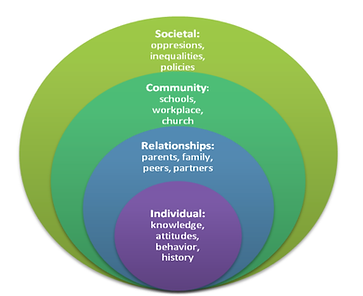
PREVENTION
SAFV's primary prevention department uses a multi-pronged approach to prevent first-time occurences of violence. Primary prevention aims to stop violence before it ever occurs by going upstream, examining the root causes of a problem, and changing the harmful conditions that perpetuate the problem. This protects a person from risk of incident before it ever happens.
Julia Smith, SAFV's prevention director, has been working in violence prevention since 2006. (Photo by Anne Brice, SAFV)
There are many examples of using this multi-pronged approach to create large-scale social change throughout our history. For instance, it wasn’t always popular or considered necessary to wear bike helmets or seat belts to prevent the risk of injury in the event of an accident. Through widespread campaigns, education, and policy changes, new beliefs and behaviors were established and seat belts and bike helmets are now widely used. Other examples include flu vaccinations to prevent illness, and brushing your teeth to prevent tooth decay. In our case, SAFV is promoting healthy relationships and respect to prevent domestic violence and sexual assault in our community.
Other types of prevention include secondary and tertiary prevention. Secondary prevention takes place immediately following an incident to prevent a reocurrence. This can include interrupting the incident to get vicitms to safety, arresting a perpetrator of violence, safety planning with survivors of violence, providing community education on the dynamics of domestic violence, and crisis and emergency services. Tertiary prevention is ongoing and addresses the longterm consequences of violence, including support services for children, counseling, batterer's programs, lethality assessments, and legal advocacy.
OUR APPROACH

We all live within the context of community and societal norms that influence and shape who we are and the choices we make. Primary prevention works to shift the norms that lead to and perpetuate violence.
Over time, this approach will ultimately create large-scale social change where an environment of respect is common and perpetration of domestic violence and sexual assault is less likely to occur.
Working across the socio-ecological model brings about change in individuals, relationships, communities, and societies.
If new, healthier behaviors are consistently demonstrated and encouraged in multiple areas of a person's life -- at home, at school and after-school programs, within peer groups, at sports practice, at the doctor's office, in the media, and in our agency and community settings and policies -- our beliefs, attitudes, and behaviors will shift to create new social norms that support a healthier community, where violence is outside the norm.
This is the public health approach to ending domestic violence and sexual assault. In order to effectively create change, prevention strategies must be comprehensive, ongoing, and multilayered, and be delivered in a number of ways, including in media messages, through positive role modeling, and by teaching healthy social and emotional skills.
Over time, this approach will ultimately create large-scale systemic shifts where an environment of respect is the norm and violence is perceived and treated as unacceptable behavior. To learn more about primary prevention, watch these Short Videos by the Alaska Network on Domestic Violence and Sexual Assault (ANDVSA) that give a detailed description of primary prevention concepts.

Girls on the Run practice. (Photo by Anne Brice, SAFV)
LOCAL EFFORTS

In Sitka, we are working diligently to counteract the epidemic of domestic violence (DV) and sexual assault (SA).
Since 2004, SAFV has been a recipient of the Centers for Disease Control and Prevention DELTA (Domestic Violence Prevention Enhancements and Leadership Through Alliances) funding to establish a community prevention coalition and plan, implement, and evaluate prevention programming.
Sitka, Alaska. (Photo by Anne Brice, SAFV)
SAFV has also been a recipient of several statewide grants to build community capacity for our prevention efforts. These grants have allowed us to establish organizational buy-in for primary prevention at SAFV and strengthen community partnerships that have led to the implementation of successful prevention programs in Sitka.
SAFV has successfully coordinated an interconnected prevention coalition, developed a long-term community prevention plan inclusive of four goals and implemented many programs that build resiliency and reinforce messages of respect and healthy relationships across the community of Sitka.
SAFV is part of a statewide network working to address DV/SA in Alaska called the Alaska Network on Domestic Violence and Sexual Assault (ANDVSA). ANDVSA is made up of 18 member programs that provide services to victims of domestic violence and sexual assault.

Prevention specialists from around the state come together every year to discuss violence prevention. (Photo by Anne Brice, SAFV)
COMMUNITY COALITION

Pathways to a Safer Sitka is Sitka’s primary prevention coalition comprised of 10 organizations representing a diverse cross-seciton of the community. Pathways was formed by SAFV in 2008 to develop a community-wide plan for preventing first time occurrences of domestic violence (DV) and sexual assault (SA).
To achieve our vision, several goals were created:
Pathways partners meet at the Pioneer Home Manager's House for the group's quarterly retreats. (Photo by Anne Brice, SAFV)
-
GOAL 1: Sitka schools have increased the extent to which they promote and foster health social-emotional environments..
-
GOAL 2: Youth are proactive within school and after-school settings that support positive peer culture.
-
GOAL 3: Boys and men are proactive within the community in building mutual respect and equality between men and women.
-
GOAL 4: Social service agencies have increased the extent to which they promote and foster healthy social-emotional environments.
Here is the complete prevention plan: Pathways to a Safer Sitka. For more information please contact SAFV's Prevention Director at prevention@safv.org.
PATHWAYS PARTNERS

Pathways to a Safer Sitka maintains a prevention focus by meeting quarterly for retreats that provide opportunity and space to share resources, connect with partner agencies, reflect, review and make improvements to our prevention plan as necessary.
Our coalition partners play a significant role in the planning, implementation, and evaluation of the Pathways plan with each agency connected to and actively working on at least one goal.
The Sitka Native Education Program is one of SAFV's key partner agencies. (Photo by Anne Brice, SAFV)
Our partners include Sitka Tribe of Alaska, Sitka Native Education Program, Center For Community, Sitka Counseling & Prevention Services, Youth Advocates of Sitka, Sitka School District, Mount Edgecumbe High School, Kettleson Memorial Library.
The Sitka Native Education Program, as part of the Sitka Tribe of Alaska, is spearheading the Lingít language and cultural K-12 curriculum being developed in partnership with the Sitka School District. Emphasis on cultural heritage and family traditions not only builds resiliency within an individual, but also creates opportunities for building respect and understanding of differences within schools and across communities.
The Sitka School District has also been working to incorporate healthy relationships courses within the school curriculum. For the past several years, the school has implemented the Fourth R ("R" stands for "relationships"), a comprehensive, skill-based program for grades 7-9 that promotes healthy relationships and nonviolence. Teaching young people about healthy relationships is a core component in preventing interpersonal violence. Teens are more at risk for intimate partner violence than adults, and the severity among partners has been shown to increase if the pattern of abuse was established in adolescence.
Mt. Edgecumbe High School has been active in engaging its students in events, like the annual Choose Respect March and programs, like the Sitka Youth Leadership Committee, that aim to foster youth leadership in building a community of respect and nonviolence. There is a growing number of youth leaders in Alaska working together to influence positive change and promote a peer culture of respect and equality. Youth leadership is important to the movement in ending violence, as young people typically influence one another as much or more than adults in their lives do.
Sitka Counseling & Prevention Services has been implementing programs including Active Parenting Now and Children In Between to support healthy parenting. These programs teach parents how to raise a child by using encouragement, building the child's self-esteem, and creating a relationship with the child based on active listening, honest communication, and problem solving. Read more about Sitka Counseling.
PREVENTION PROGRAMS & EFFORTS
SCHOOLS

Teachers, administrators, coaches, and mentors have as much influence as parents in shaping and molding our youth and play a vital role in the development of young people—both academically as well as socially and emotionally. There are many ways that schools can incorporate healthy relationship conversations and promote a culture of respect within the school environment. To learn more, go to our Schools page.
YOUTH LEADERSHIP

Youth leadership is important to the movement in ending violence. There is a growing number of youth leaders in Alaska working together to influence positive change and promote a peer culture of respect and equality. There are several opportunities in Sitka for youth to engage in community projects to end violence. To learn more, go to our Youth Leadership page.
MEN & BOYS

It is essential for men to be equal partners with women in ending domestic violence and sexual assault, and in promoting a culture of respect within communities. There are numerous opportunities in Alaska for men to work together as allies to end violence, to become positive role models for boys and young men, and to explore healthy masculinity and redefine what it means “to be a man” in our society. To learn more, go to our Male Engagement page. You can also visit Coaching Boys Into Men pages or Boys Run I Toowú Klatseen for information about specific programs.
FAMILIES

In Sitka there are several programs designed to equip parents with healthy parenting skills, ways to talk to their children about healthy relationships, and opportunities to connect and share resources with other parents. There are also numerous ways that healthcare practitioners can work with families to interrupt the cycle of violence and provide families with healthy relationships guidance. To learn more, go to our Families page.



